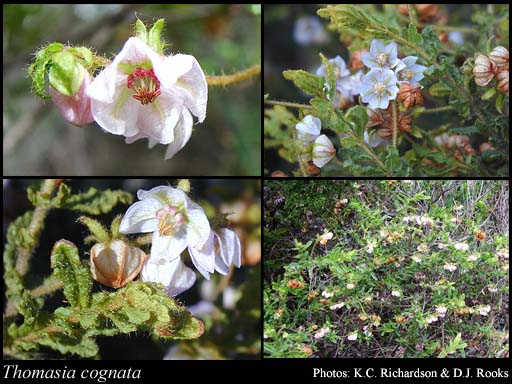- Reference
- Lehm., Pl.Preiss. [J.G.C.Lehmann] 1:232 (1845)
- Conservation Code
- Not threatened
- Naturalised Status
- Native to Western Australia
- Name Status
- Current
Multi-stemmed shrub, 0.1-0.7 m high. Fl. pink-purple, Aug to Nov. White/grey or yellow sand. Coastal limestone & dunes.







Scientific Description
Shrub, with hairy stems. Leaves 10-40 mm long, 3-10 mm wide, not lobed; margins crenate; hairy, with stellate hairswith scales absent, Sessile glands absent; stipules present but early deciduous (only visible on youngest leaves), 4.8-10 mm long. Perianth of two whorls but the corolla reduced to small scales or tiny lobes at the base of the ovary or of one whorl only (the visible whorl is a calyx, sometimes petaloid) (by misinterpretation). Pedicel present, 3-4 mm long; indumentum present, with stellate hairs present, with scales absent. Epicalyx (extra segments or 'bracteoles' immediately below the calyx) present, 6.5-7 mm long, the lobes free, indumentum present, simple hairs (without tubercle bases) absent, stellate hairs present, gland-tipped hairs absentwith scales absent, Sessile glands absent. Calyx pink or purple, 6.5-8 mm long, the lobes fused half or more of their length, Sessile glands absent, simple hairs (without tubercle bases) absent, stellate hairs present, tubercle-based simple hairs absent, gland-tipped hairs absent, scales absent, Terminal appendages absent, number of ribs present, one. Corolla glabrous. Indumentum (outside) Sessile glands absent. Stamens five, free and inserted at the base of the ovary; filaments present, 1.3-1.6 mm long; anthers 1.4-2.2 mm long, indumentum absent (anthers glabrous). Staminodes absent, appendages absent. Ovary hairs or scales present, simple hairs absent, stellate hairs present, gland-tipped hairs absent; style 1, with a lobed or capitate stigma, 1.6-2 mm long, with one style branches or lobes, mostly glabrous, wing absent. Flowering time August, September, October or November. Distribution Botanical Province South-West, IBRA Bioregion Geraldton Sandplains, Swan Coastal Plain, Jarrah Forest, Warren and Esperance.
Distribution
- IBRA Regions
- Esperance Plains, Geraldton Sandplains, Jarrah Forest, Swan Coastal Plain, Warren.
- IBRA Subregions
- Fitzgerald, Geraldton Hills, Perth, Recherche, Southern Jarrah Forest, Warren.
- IMCRA Regions
- Leeuwin-Naturaliste, WA South Coast.
- Local Government Areas (LGAs)
- Albany, Augusta Margaret River, Busselton, Cockburn, Dandaragan, Esperance, Harvey, Jerramungup, Nannup, Northampton, Rockingham, Wanneroo, Waroona.